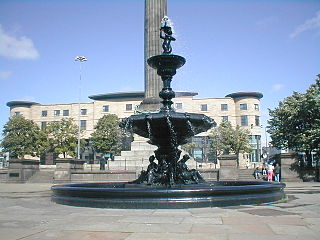
Islington is a district in the north of Greater London, England, and part of the London Borough of Islington. It is a mainly residential district of Inner London, extending from Islington's High Street to Highbury Fields, encompassing the area around the busy High Street, Upper Street, Essex Road, and Southgate Road to the east.

Merseyside is a ceremonial and metropolitan county in North West England. It borders Lancashire to the north, Greater Manchester to the east, Cheshire to the south, the Welsh county of Flintshire across the Dee Estuary to the southwest, and the Irish Sea to the west. The largest settlement is the city of Liverpool.

Birkenhead is a town in the Metropolitan Borough of Wirral, Merseyside, England; It was part of Cheshire until 1974. The town is on the Wirral Peninsula, along the west bank of the River Mersey, opposite Liverpool. At the 2011 census, it had a population of 88,818.

The Walker Art Gallery is an art gallery in Liverpool, which houses one of the largest art collections in England outside London. It is part of the National Museums Liverpool group.

Albert Square is a public square in the centre of Manchester, England. It is dominated by its largest building, the Grade I listed Manchester Town Hall, a Victorian Gothic building by Alfred Waterhouse. Other smaller buildings from the same period surround it, many of which are listed.

The County Sessions House is a former courthouse in Liverpool, Merseyside, England. It stands at the top of William Brown Street. It is adjacent to the Walker Art Gallery, the Steble Fountain and Wellington's Column. It now provides office and storage space for the gallery. The Session House is recorded in the National Heritage List for England as a designated Grade II* listed building.

The Steble Fountain stands in William Brown Street, Liverpool, England, to the west of Wellington's Column. It is recorded in the National Heritage List for England as a designated Grade II* listed building. It was donated to the city by a former mayor to fill a vacant plot to the west of the column. For much of the 2010s and 2020s, the fountain has needed repair and has not functioned.

Lime Street in Liverpool, England, was created as a street in 1790. Its most famous feature is Lime Street railway station. It is part of the William Brown Street conservation area.
Grade I, Grade II* and notable Grade IIlisted buildings in the metropolitan boroughs of Knowsley, Liverpool, Sefton, St Helens and Wirral in Merseyside.

Birmingham city centre, also known as Central Birmingham, is the central business district of Birmingham, England. The area was historically in Warwickshire. Following the removal of the Inner Ring Road, the city centre is now defined as being the area within the Middle Ring Road. The city centre is undergoing massive redevelopment with the Big City Plan, which means there are now nine emerging districts and the city centre is approximately five times bigger.

Liverpool Maritime Mercantile City is a former UNESCO designated World Heritage Site in Liverpool, England, that comprised six locations in the city centre including the Pier Head, Albert Dock and William Brown Street, and many of the city's most famous landmarks.

The architecture of Liverpool is rooted in the city's development into a major port of the British Empire. It encompasses a variety of architectural styles of the past 300 years, while next to nothing remains of its medieval structures which would have dated back as far as the 13th century. Erected 1716–18, Bluecoat Chambers is supposed to be the oldest surviving building in central Liverpool.
There are over 2500 listed buildings in Liverpool, England. A listed building is one considered to be of special architectural, historical or cultural significance, which is protected from being demolished, extended or altered, unless special permission is granted by the relevant planning authorities. Of the listed buildings in Liverpool, 105 are classified as Grade II* listed and are recognised as being particularly important with more than special architectural or historic interest. Of these, 46 are located within the L1, L2 and L3 postcodes, which cover the city centre of Liverpool. The following list provides information on all the Grade II* listed buildings within these postcodes.

Liverpool city centre is the commercial, cultural, financial and historical centre of Liverpool and the Liverpool City Region, England. Different definitions of the city centre exist for urban planning and local government, however, the border of Liverpool city centre is broadly marked by the inner city districts of Vauxhall, Everton, Edge Hill, Kensington and Toxteth.
The following is a timeline of the history of the city of Liverpool, England.

Paradise, formerly named Paradise Circus, is the name given to an area of approximately 7 hectares in Birmingham city centre between Chamberlain and Centenary Squares. The area has been part of the civic centre of Birmingham, England since the 19th century when it contained buildings such as the Town Hall, Mason Science College, Birmingham and Midland Institute buildings and Central Library. The site was redeveloped from 1960 to 1975 into the present Paradise Circus based within a roundabout on the Inner Ring Road system containing a new Central Library and School of Music. From 2015, Argent Group will redevelop the area into new mixed use buildings and public squares.

Cornelius Sherlock was a British architect who was active in Liverpool in North West England in the late 19th century.

George's Dock Building is a Grade II listed building in Liverpool, England. It is located at the Pier Head on the city's waterfront. It is part of Liverpool's former UNESCO designated World Heritage Maritime Mercantile City. It was built in the 1930s in the Art Deco style, and designed by architect Herbert Rowse. Occupants of the office space include, Merseytravel, The Liverpool City Region Combined Authority, Mersey Tunnels staff and The Mersey Tunnels Police. It also houses ventilation machinery for the Queensway Tunnel and the Mersey Tunnels Tour Offices.
























